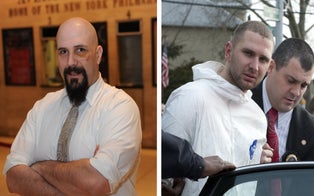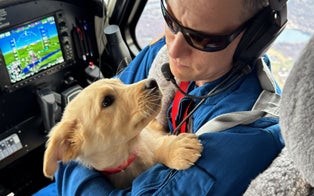Gus, Westley and Waffle were the relay team of running guide dogs that helped 49-year-old Thomas Panek cross the finish line.
One small half-marathon for man, one giant leap for guide dogs everywhere as a relay team of three trained canines made history by successfully leading a blind marathoner to the finish line for the first time in history.
Thomas Panek, a 49-year-old from South Salem, New York, successfully completed the 2019 United Airlines NYC Half, but he couldn’t have done it without the help of Gus, Westley and Waffle, the three guide dogs trained to lead the blind on runs.
“It’s hard not to be able to see,” Panek said, moments after crossing the finish line Sunday. “But just to say to people who are blind, get out there. You can do it. You can do anything.”
Panek, who has done 20 marathons as a blind adult, including five Boston Marathons, three New York City Marathons, a Marine Corps Marathon and a California International Marathon, completed the half-marathon in two hours, 20 minutes and 51 seconds.
However, this was the first time he completed any race with the help of guide dogs. In fact, the feat is first in both the running and blind communities.
Just years ago, guide dogs leading a blind person on a run was considered dangerous. Today, nonprofit organization Guiding Eyes for the Blind has trained more than a dozen guide dogs to independently lead the blind in running.
“There are a lot of obstacles he has to navigate – left and right, around,” Panek, the organization’s CEO, explained. “It was a little scary because along one part of the course, you run along the FDR [Drive]. There are cars coming right at you on the other side. I hear these cars at 55 miles an hour, but he’s so calm, and he’s so together. He knows what he’s doing. He just guided me on the course safely and got me to the finish line.”
The half-marathon was split up into portions among the three dogs. Westley, a 2-year-old black Labrador, led Panek in the first leg. At the five-mile mark, trainers, running specialists and veterinarians with Guiding Eyes for the Blind helped switch off and tether Panek to Westley’s sister, Waffle, a 2-year-old yellow Labrador. Panek then completed the race led by Gus, the oldest member of their team at 7 years old.
“The streets were so crowded with fans cheering, it was fantastic,” Panek said.
When it came to accepting the medals, Panek was less concerned with his own victory. In fact, as a volunteer went to put the medal around his neck, he said, “No, no, no, no, no. Him first,” gesturing to his personal guide dog and the anchor of the race, Gus.
'My World Started to Go Dark'
Panek said he began running competitively when he joined the cross-country team in high school. It was also around that time that he began losing his vision.
“I would always follow the runner in front of me, afraid to get out front,” he told InsideEdition.com. “It wasn’t the running that limited me, it was my vision and eventually I lost my eyesight due to a genetic condition.”
Panek was diagnosed with retinitis pigmentosa (RP), a rare disorder that involves the loss of cells in the retina.
“My vision condition is almost like watching the leaves on a tree fall off one at a time until eventually there’s nothing left,” he explained. “The peripheral vision starts to go, eventually you have tunnel vision, and you can’t see at night, and then over time, you can barely see anything at all. I had a driver’s license, I was active, and then my world started to go dark.”
Panek was 26 years old when he was declared legally blind.
He stopped running years before his diagnosis when he started getting hurt but picked it up again in his late 30s.
“A friend of mine called and said, ‘I heard you were a runner before and human guides can tether to help you run,’” Panek recalled. “So he said, ‘Why don’t you get out there and do a 10-miler?’ At the time, running 10 miles was a lot. So I started just like anybody else, one mile at a time, conditioning, guided by people who were volunteering to be human guides.”
Nick Speranza, a running guide specialist with Guiding Eyes for the Blind, first met Panek as his volunteer running guide.
“It’s just two guys going for a run with a little audio description,” Speranza explained of their guided runs. “The guide will use a tether of various forms – some do an elbow hold or shoulder hold. Tom prefers a tether, which could be something as simple as a shoestring to a bungee cord. It’s what works best for the individual runner. He’s able to get tactile feedback from that as well as verbal cues that I’m giving about what the environment is – such as potholes on the road, low branches.”
Man's Best Running Partner?
Just months after they began running together, Panek began wondering what it might be like training his guide dog to run with him.
“It’s hard when you rely on a human guide to run. They also have to be in the mood to run,” Panek said. “Running is also a solo sport for a lot of people. You want to get out there and be with your own space. It’s just like anybody who wants to be independent and not relying on another human being for every step. I want to be independent too.”
Jolene Hollister, a class supervisor at Guiding Eyes for the Blind, explained that just five years ago, the idea of running alongside a guide dog was unthought of.
“It was considered taboo and against the rules to run with your guide dog,” Hollister told InsideEdition.com. “It was always assumed that a guide dog can’t make decisions and maintain safety for the team while running.”
She explained that of all the dogs that the nonprofit encounters, about 50 percent make it to become guide dogs and 10 percent of those have the makings to become running guides.
“The first step of evaluating that is taking the dog out for a run and basically asking, do you enjoy this?” Hollister said. “Those dogs that go out there like, ‘Really? I can run? Everybody has told me I have to slow down. You’re giving me the green light?’ Those are the dogs that are going to stay with us and continue to be exposed to running, making decisions like that at a faster pace as well as building up stamina and fitness level.”
Panek explained everything changed for him after they trained his guide dog Gus to run.
“The feeling was freedom,” he said. “It’s almost like when you’re a kid and you start running for the first time and you run as fast as you can. That’s how it felt.”
While the program is fairly new and the waiting list for running guides is incredibly long, Panek said he hopes training guide dogs to lead runs will help more blind people get active – whether they have dreams of running a marathon or going for a morning jog in the park.
“We all want to be healthy, we all want to be well, but if you lose your vision, it’s hard to get across the room, let alone be active,” Panek said. “It’s really important that we all stay active no matter what the disability is, so that you can participate as fully as you can in all of life’s activities, no matter how big or small.”
His older brother Andrew, who was also a runner in high school, never got the chance to pursue the hobby again after his blindness set in. He was 49 when he died last year.
“He never received one of these wonderful running guides,” Panek said. “I wish, if I had known that that would have happened to him, that he would have passed away, I wish I could have given him a running guide. That would have been very special.”
RELATED STORIES





